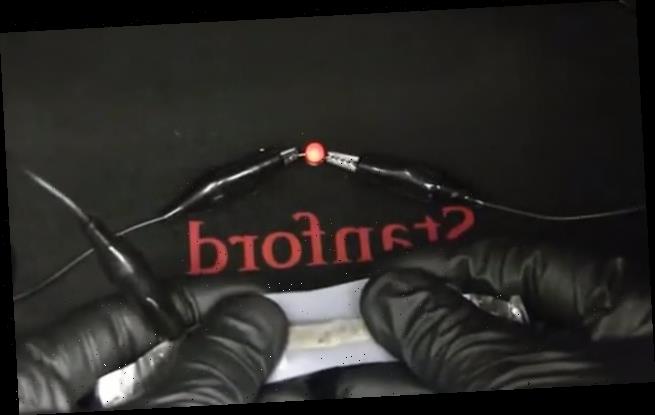Researchers at Stanford develop a durable new battery that can be pulled and stretched like TAFFY without any reduction in power or efficiency
- Scientists at Stanford Engineering have developed a stretchy new battery
- The battery can be pulled to twice its resting length with no reduction in power
- The team believes it could be used in a wide range of wearable health devices
Researchers at Stanford Engineering have developed a flexible new battery housed in plastic that will be able to stretch and bend in the same ways human bodies do.
The team believes the new device could be useful in the growing market for wearable computing devices like fitness trackers and smart watches, providing a lightweight power source that can adapt to a wide range of sizes and applications.
In conventional lithium ion batteries, particles of plastic, called polymers, are used to conduct negative ions toward the battery’s positive pole, creating power for any device they’re connected to.
Scroll down for video
Researchers at Stanford have developed a stretchy new battery (pictured above) that can be pulled to twice its original length with no interruption to its power supply
In lithium ion batteries, those polymers take the form of gels housed in a rigid casing, a system that has proven flammable in the past.
The Stanford team say their new battery have converted these polymers into a solid and stretchy substance instead of a gel, which makes its battery both more flexible and less flammable.
Importantly, the battery’s ability to deliver power doesn’t change based on the shape it’s pulled or pressed into.
The team stretched the battery out to twice its original length and found no corresponding power loss.
‘Until now we haven’t had a power source that could stretch and bend the way our bodies do, so that we can design electronics that people can comfortably wear,’ chemical engineer Zhenan Bao told Stanford Engineering magazine.
The prototype version of the battery is around the size of a thumbnail and stores around half the energy of a conventional battery of the same size.
Researchers hope to continue developing the technology to be able to store even more energy ounce per ounce and believe it could also be used with BodyNet, a flexible family of wearable computing devices also being developed at Stanford.
BodyNet is an ambitious project that seeks to develop a full-body skin-sensor array to collect a wide range of biometric data.
Researchers say the battery is less flammable than traditional lithium ion batteries, that use a polymer gel to carry negative ions toward a positive pole, because the gel can leak
The battery is being developed with another Stanford research project in mind called BodyNet (pictured above), network of wearable sensors mean to adhere to a person’s skin and collect a wide range of biometric data
Last year, researchers showed a BodyNet prototype with metallic ink as an antenna embedded in a stretchable sticker that would adhere to a person’s skin and measure their pulse, body temperature, stress levels, and a variety of other health indicators.
Stanford chemical engineering professor Zhenan Bao, who helped develop the technology, says it could eventually be used to help monitor patients struggling with a range of health conditions, including sleep disorders and heart conditions.
‘We think one day it will be possible to create a full-body skin-sensor array to collect physiological data without interfering with a person’s normal behavior,’ said Bao
HOW DOES WEARABLE TECH WORK?
Fitness trackers such as Fitbits or smart watches monitor heart rate using a technique called photoplethysmography.
The tracker sends green light through the skin which is partially absorbed by arteries.
As you exercise, these arteries expand as blood flow increases – meaning more green light is absorbed rather than reflected back to the tracker.
The tracker estimates your heart rate by seeing how much light is reflected back.
The amount of light that passes back through the skin to the tracker can be affected by the amount of melanin in the skin, and any tattoos.
One of the key measuring tools of wearable sleep monitors is called actigraphy which has been used in medical sleep tests for decades.
Actigraphy records movement through a measuring device called an accelerometer.
The idea is that a certain amount of movement will be recorded as ‘awake’ and periods of being still corresponds with being ‘asleep’.
Sleep trackers with a heart rate tracking feature can measure your variations in heart rate to assess sleep quality and other parameters.
Trackers that measure the body’s core temperature use this information to predict stress levels and fertility, for example.
Source: Read Full Article



